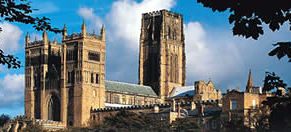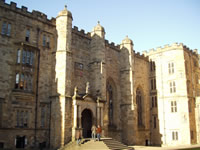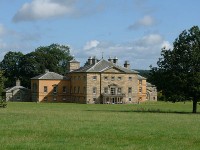For those of us who fell in love with the legends of Camelot, read the Lord of the Rings over and over again and watched breathlessly as armies clashed in modern movies like Braveheart, there can be only one nation that can bring these dreams to life: the United Kingdom. All of the great fantasy tales have their foundation in some English myth or historical event from the medieval age. There are many places to visit if dreaming of knights is your passion. And when planning your tour, be sure to put Durham on your list. Set on a peninsula above the River Wear just south of the Scottish border, the town of Durham is drenched in old English charm and wonder.
 Durham Cathedral is the heart and soul of the city, even now, and fittingly enough was the first building erected in Durham more than 1000 years ago. Monks from the island of Lindisfarne arrived here carrying the remains of Saint Cuthbert, a renowned Middle Age healer, and found that the hill atop the peninsula provided the glory and protection they wanted for the resting place of their saint. Less than 100 years later, the Normans invaded England in 1066 and wrested control of the nation from Harold. They promptly marched up to Durham and built a great castle to demonstrate their dominion over all of England. Soon the castle and the cathedral, built atop the modest home the Lindisfarne monks had built, faced each other regally across the Palace Green. The bishop, appointed by the Normans, commanded extraordinary powers as Prince Bishop by Divine Providence and made his home in the castle. Under the powers of the Church and the Bishop, Durham rose to be one of the greatest towns in England from the 13th to the 19th century.
Durham Cathedral is the heart and soul of the city, even now, and fittingly enough was the first building erected in Durham more than 1000 years ago. Monks from the island of Lindisfarne arrived here carrying the remains of Saint Cuthbert, a renowned Middle Age healer, and found that the hill atop the peninsula provided the glory and protection they wanted for the resting place of their saint. Less than 100 years later, the Normans invaded England in 1066 and wrested control of the nation from Harold. They promptly marched up to Durham and built a great castle to demonstrate their dominion over all of England. Soon the castle and the cathedral, built atop the modest home the Lindisfarne monks had built, faced each other regally across the Palace Green. The bishop, appointed by the Normans, commanded extraordinary powers as Prince Bishop by Divine Providence and made his home in the castle. Under the powers of the Church and the Bishop, Durham rose to be one of the greatest towns in England from the 13th to the 19th century.
 For travellers, Durham is a good place to stop before heading north into Scotland (or returning). The town escaped the ravages of the Industrial Revolution, despite the coal mines prevalent in the area, and remains to this day a pristine, wooded and walled town hugging the banks of the slow moving River Wear. Since Durham University was founded in the late 1800s, the town has seen an infusion of young blood each year that contrasts smoothly with the great walls of the castle and the silent woods along the Wear. To accommodate young tastes, pubs and restaurants have popped up along the river and the marketplace at the foot of the cathedral. Rooms and small apartments are available during the summer for rock bottom prices — landlords have to make due when the kids leave, so summer might be a great time to spend a few days in Durham.
For travellers, Durham is a good place to stop before heading north into Scotland (or returning). The town escaped the ravages of the Industrial Revolution, despite the coal mines prevalent in the area, and remains to this day a pristine, wooded and walled town hugging the banks of the slow moving River Wear. Since Durham University was founded in the late 1800s, the town has seen an infusion of young blood each year that contrasts smoothly with the great walls of the castle and the silent woods along the Wear. To accommodate young tastes, pubs and restaurants have popped up along the river and the marketplace at the foot of the cathedral. Rooms and small apartments are available during the summer for rock bottom prices — landlords have to make due when the kids leave, so summer might be a great time to spend a few days in Durham.
 Both the cathedral and the castle are UNESCO World Heritage Sites and are open to the public. It is actually possible to stay in the castle during the summer months. The remains of Saint Cuthbert are on display in the cathedral and the Great Hall of the impregnable Durham Castle is also open to visitors during the day. The River Wear has boat operators that allow for couples to take a quick row under the bridges and parkways and paths line the river from one part of town to the other.
Both the cathedral and the castle are UNESCO World Heritage Sites and are open to the public. It is actually possible to stay in the castle during the summer months. The remains of Saint Cuthbert are on display in the cathedral and the Great Hall of the impregnable Durham Castle is also open to visitors during the day. The River Wear has boat operators that allow for couples to take a quick row under the bridges and parkways and paths line the river from one part of town to the other.
Durham is a small town and it is possible to walk the whole of it in just half a  day. All of the major sites — the river, the cathedral and castle, the bridges and marketplace — are very close together and can be visited at a leisurely pace. In the surrounding areas are other Norman, Anglo-Saxon and Roman sites open to visitors, such as Barnard Castle, a marketplace town built around the remains of a 12th century castle anda classic English villa just south of the castle. Just outside of Durham is the Beamish Open Air Museum, where the history of the area comes to life in historic replicas of homes, schools, mine shafts and working pubs (!).
day. All of the major sites — the river, the cathedral and castle, the bridges and marketplace — are very close together and can be visited at a leisurely pace. In the surrounding areas are other Norman, Anglo-Saxon and Roman sites open to visitors, such as Barnard Castle, a marketplace town built around the remains of a 12th century castle anda classic English villa just south of the castle. Just outside of Durham is the Beamish Open Air Museum, where the history of the area comes to life in historic replicas of homes, schools, mine shafts and working pubs (!).
The best way to enjoy this place is with 2-3 days (maybe more) of quiet walking around the almost legendary sites of ages past, with a good hearty English dinner and ale at the end of the day. To really punctuate your Durham visit, I suggest a little time spent in a rowboat on the river. Sir Walter Scott did just this several hundred years ago, and when he stopped on one walk to stare up at the cathedral, he wrote these lines, carved into the stone of Prebend Bridge:
“Grey towers of Durham
Yet well I love thy mixed and massive piles
Half church of God, half castle ‘gainst the Scot
And long to roam those venerable aisles
With records stored of deeds long since forgot.”


Comments